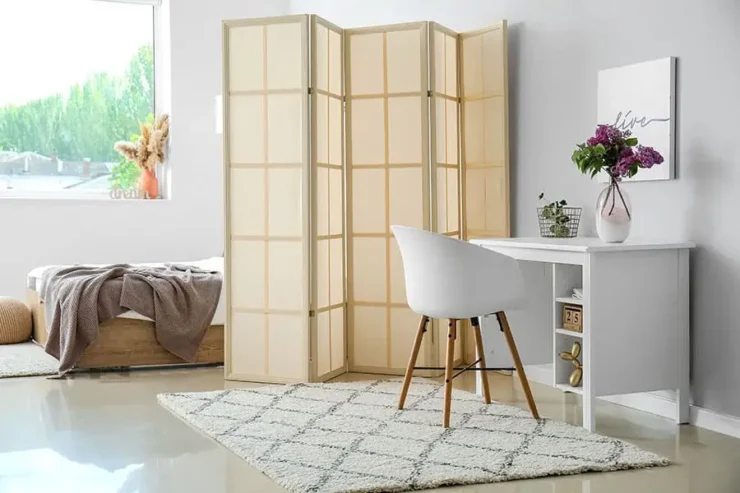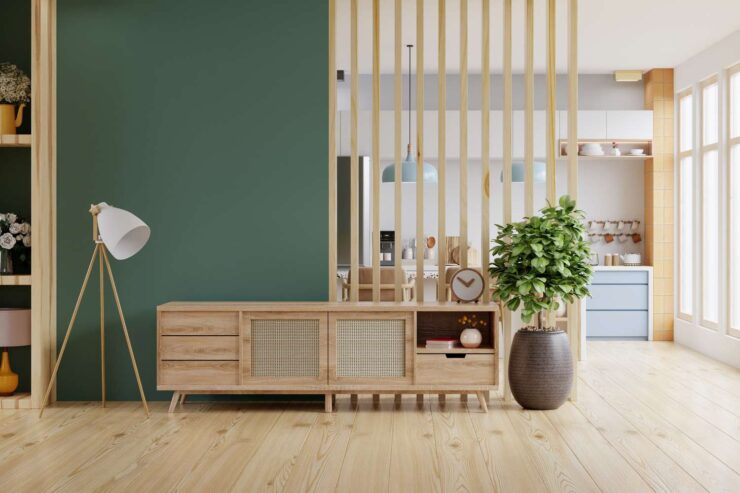Table of Contents
Room dividers are versatile elements in interior design, combining functionality and aesthetics. They transform open spaces, offer practical solutions for organization and privacy, and add style to your home. In this guide, we’ll explore room divider types, their pros and cons, and how they enhance functionality and organization.
Types of Room Dividers
Room dividers come in various types, such as folding screens, bookshelves, curtains, and a sliding room divider. Each has unique features to consider.
Folding screens are elegant and portable but may lack full privacy. Bookshelves combine storage and separation but require upkeep. Curtains are budget-friendly but may not provide sound insulation. Sliding panels are modern but may lack decorative charm. Your choice depends on your needs and preferences.
Functional Division
Room dividers create practical divisions in open spaces, defining separate areas for various activities. They are particularly useful in open floor plans and multi-purpose rooms. For instance, they add privacy to sleeping areas or improve organization. Moreover, some space dividers offer built-in storage, combining functionality and aesthetics effectively.
Aesthetic Appeal

Beyond their practicality, room dividers enhance a room’s aesthetics. They can serve as decorative focal points, infusing character and style into spaces. For example, wooden folding screens add traditional elegance, while glass partitions bring modern sophistication. Material choice, design, and finish impact the room’s ambiance. Space dividers also allow experimentation with texture and visual interest, using materials like rattan or metal to create intriguing effects.
Material Matters
Materials used in room dividers significantly impact a room’s character. Common materials include wood, metal, glass, fabric, bamboo, and rattan. Wood exudes warmth, metal offers a contemporary look, glass adds sophistication, fabric introduces softness, and bamboo and rattan bring a relaxed atmosphere. Material choice should align with your design theme.
DIY Dividers
Crafting your own room divider adds a personal touch to your home decor. It allows you to customize your space according to your style and needs. Here are some creative DIY divider ideas to inspire you:
Hanging Plant Divider: Create a living wall by suspending a variety of potted plants from a wooden frame. This not only defines spaces but also adds a refreshing burst of greenery to your interior.
Fabric Screen: Sew or tie together colorful fabric panels to form a decorative room divider. You can mix and match fabrics to suit your color scheme and create a unique, bohemian look.
Reclaimed Door Divider: Repurpose old doors by attaching them together vertically or horizontally. Sand, paint, or distress them to match your decor style for a vintage, shabby chic divider.
PVC Pipe Partition: For a modern and industrial vibe, construct a space divider using PVC pipes and connectors. Spray paint them in metallic finishes for an edgy look.
Wooden Pallet Wall: Collect wooden pallets and stack them to form a rustic, textured divider. You can leave them unfinished for a natural look or paint them to match your decor.
Metal Screens: For an industrial or minimalist look, metal partitions bring durability and a striking visual element. Laser-cut designs can add intricate patterns, combining functionality with artistry.
Bamboo and Rattan: These eco-friendly materials provide a light, breathable partition perfect for bohemian or tropical-inspired interiors. Their organic textures enhance natural aesthetics while maintaining a sense of openness.
Glass Partitions: A modern and sophisticated choice, glass partitions allow natural light to flow through while maintaining separation. They are ideal for defining spaces without making a room feel smaller. Available in clear, frosted, or mirrored finishes, they enhance openness and provide a sleek, contemporary touch.
These DIY projects not only personalize your space but also unleash your creativity while saving on costs.
Divider Placement

Strategic placement is crucial to maximize the impact of your room divider on your interior design. Here are some ideas for dividing different areas of your home:
Living Room: In an open-plan living room, use a space divider to separate the seating area from the dining space. A bookshelf or screen can serve as a visual barrier while maintaining an open feel.
Bedroom: Create a cozy dressing area within your bedroom by placing a divider between your bed and a walk-in closet or vanity. This not only adds a touch of luxury but also improves organization.
Home Office: If you work from home, a room divider can define your workspace, making it easier to concentrate. Choose one with built-in storage to keep your office essentials within reach.
Nursery: In a shared nursery for siblings, use a divider to provide each child with their separate sleeping and play areas. It fosters a sense of personal space and organization.
Dining Area: In an eat-in kitchen or a small dining space, position a room divider behind the dining table to create a dedicated dining area. This delineation helps define the function of the space.
The key to effective divider placement is striking a balance between functionality and aesthetics while considering the flow of your living space.
Multi-Functional Dividers
Innovative room dividers have evolved to serve multiple functions, catering to the demands of modern living. These multi-functional dividers are designed to enhance your daily life in various ways:
Integrated Storage: Room dividers with built-in shelves, drawers, or compartments offer a convenient solution for decluttering and organization. They are particularly useful in smaller spaces where every inch counts.
Built-in Lighting: Some dividers incorporate lighting elements, such as LED strips or pendant lights, creating a cozy and inviting ambiance. These dividers not only divide the space but also set the mood.
Greenery Dividers: Bring the outdoors in with dividers that double as plant displays. These dividers infuse your space with life and natural beauty while providing separation.
Foldaway Dividers: For ultimate flexibility, consider foldaway dividers that can be easily stowed when not in use. These are perfect for transforming spaces for special occasions or gatherings.
Multi-functional dividers are a testament to the ever-evolving world of interior design, where form meets function to enhance our daily lives.
Conclusion and Final Tips

Incorporating room dividers into your home decor is a captivating journey that promises both functional and aesthetic rewards. As you embark on this adventure, remember that your home is your canvas, and dividers are the brushstrokes that help you paint your vision of stylish and functional living spaces.
In summary, consider these final tips for enhancing your living spaces with stylish room dividers:
Choose Wisely: Select a room divider type and material that align with your design preferences and needs.
DIY Creativity: Don’t shy away from DIY projects to create personalized dividers that reflect your unique style.
Strategic Placement: Position dividers strategically to define spaces and maintain a harmonious flow in your home.
Multi-Functional Marvels: Explore multi-functional dividers that offer storage, lighting, or greenery, elevating both form and function.
Aesthetic Harmony: Ensure your divider complements your chosen interior design style, whether it’s modern, traditional, bohemian, or another aesthetic.
Color and Patterns: Coordinate divider colors and patterns with your existing decor to enhance visual interest and cohesion.
Global Inspiration: Draw inspiration from room divider designs around the world, incorporating elements that resonate with your personal style.

